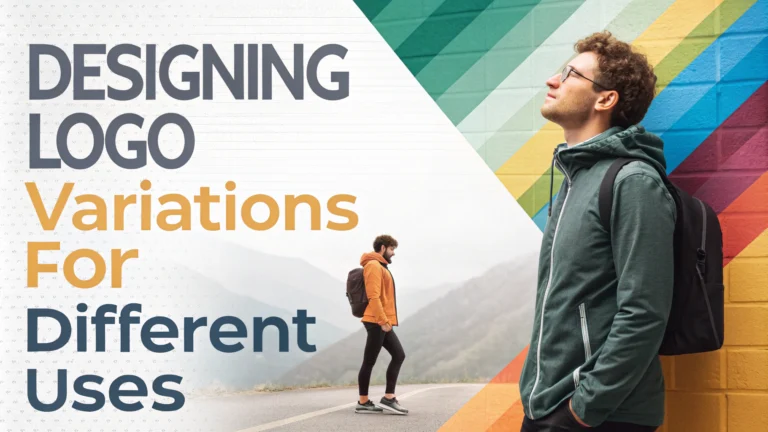Logo variations allow businesses to maintain brand consistency across different platforms and applications while adapting to specific technical requirements.
Primary Logo Formats
- Full Color Version – Your main logo for primary brand materials
- Single Color Version – For monochrome applications
- Reversed/White Version – For dark backgrounds
- Black Version – For basic printing needs
Size-Based Variations
Every logo needs at least three size variations to ensure clarity across different applications:
- Standard Size – Full logo with all elements
- Reduced Size – Simplified version for medium applications
- Icon/Symbol Only – For very small applications like favicons
Technical Specifications
| Usage | Format | Resolution |
|---|---|---|
| AI, EPS, PDF | 300 DPI minimum | |
| Digital | PNG, SVG | 72-150 DPI |
| Social Media | JPG, PNG | 72 DPI |
Platform-Specific Requirements
- Social Media Headers: 16:9 aspect ratio adaptation
- Profile Pictures: Square format with padding
- App Icons: Simplified version with enhanced visibility
- Favicon: 16×16 pixel version
File Organization
Create a clear folder structure for your logo variations:
Logo_Package/ ├── Print/ │ ├── CMYK/ │ └── Spot_Colors/ ├── Digital/ │ ├── RGB/ │ └── Web_Safe/ └── Social_Media/ ├── Profile_Pictures/ └── Headers/
Usage Guidelines
- Maintain minimum clear space around logos (typically height of logo letter)
- Never stretch or distort the logo
- Keep original proportions when scaling
- Use approved color variations only
Contact a professional logo designer through platforms like Behance or Upwork for custom logo variation development.
File Naming Convention
Use consistent naming for easy file identification:
CompanyName_LogoType_ColorVersion_Size Example: ABCCompany_Primary_FullColor_Large.ai
Additional Logo Requirements
- Vector Files – Scalable without quality loss
- Raster Files – For specific digital applications
- Color Codes – CMYK, RGB, and HEX values
- Typography Details – Font names and licensing info
Common Logo Mistakes to Avoid
- Using low-resolution files for print
- Incorrect color modes for different mediums
- Missing essential format variations
- Inconsistent branding across platforms
Quality Control Checklist
Before Final Delivery
- Test print all versions at various sizes
- Verify color accuracy across devices
- Check file compatibility with common software
- Confirm proper embedding of fonts and elements
Conclusion
Proper logo variation management ensures consistent brand representation across all platforms and applications. Maintaining organized files, following technical specifications, and adhering to usage guidelines are crucial for successful brand implementation. Regular updates and quality checks help maintain professional brand presentation across evolving digital and print landscapes.
Remember to document all logo specifications and maintain a centralized brand asset library for easy access by team members and partners.
FAQs
- What are the essential logo variations every brand should have?
Primary logo, secondary/simplified logo, favicon, monochrome version, reverse/white version, and social media profile versions. - What’s the difference between vector and raster logo files?
Vector files (AI, EPS, SVG) are scalable without quality loss, while raster files (JPEG, PNG) have fixed resolutions and lose quality when enlarged. - What are the standard logo file formats needed for different platforms?
SVG or PNG for websites, AI/EPS for print materials, JPG for email signatures, PNG with transparency for overlays, and specific pixel dimensions for social media platforms. - How should logo colors be adjusted for different backgrounds?
Create versions with reversed colors for dark backgrounds, ensure sufficient contrast, and maintain a monochrome version for single-color applications. - What are the recommended dimensions for social media logo variations?
Facebook profile (170x170px), Instagram profile (110x110px), Twitter profile (400x400px), LinkedIn company logo (300x300px), and YouTube profile (800x800px). - How do you ensure logo legibility at different sizes?
Create simplified versions for small applications, remove fine details for tiny sizes, and test readability across all dimensions from favicon to billboard size. - What’s the importance of responsive logos?
Responsive logos adapt to different screen sizes and contexts, maintaining brand recognition while ensuring optimal visibility across all devices and platforms. - How should logos be modified for favicon use?
Simplify the design to work at 16×16 pixels, focus on the most recognizable element, and ensure clarity at small sizes. - What are the key considerations for print vs. digital logo variations?
Print logos need CMYK color mode and higher resolution, while digital logos use RGB colors and must work across various screen sizes and backgrounds. - How should logo files be organized and named for different uses?
Use clear naming conventions indicating format, color mode, and purpose (e.g., BRANDNAME_Primary_CMYK.ai, BRANDNAME_Social_RGB.png) and organize in folders by application type.







